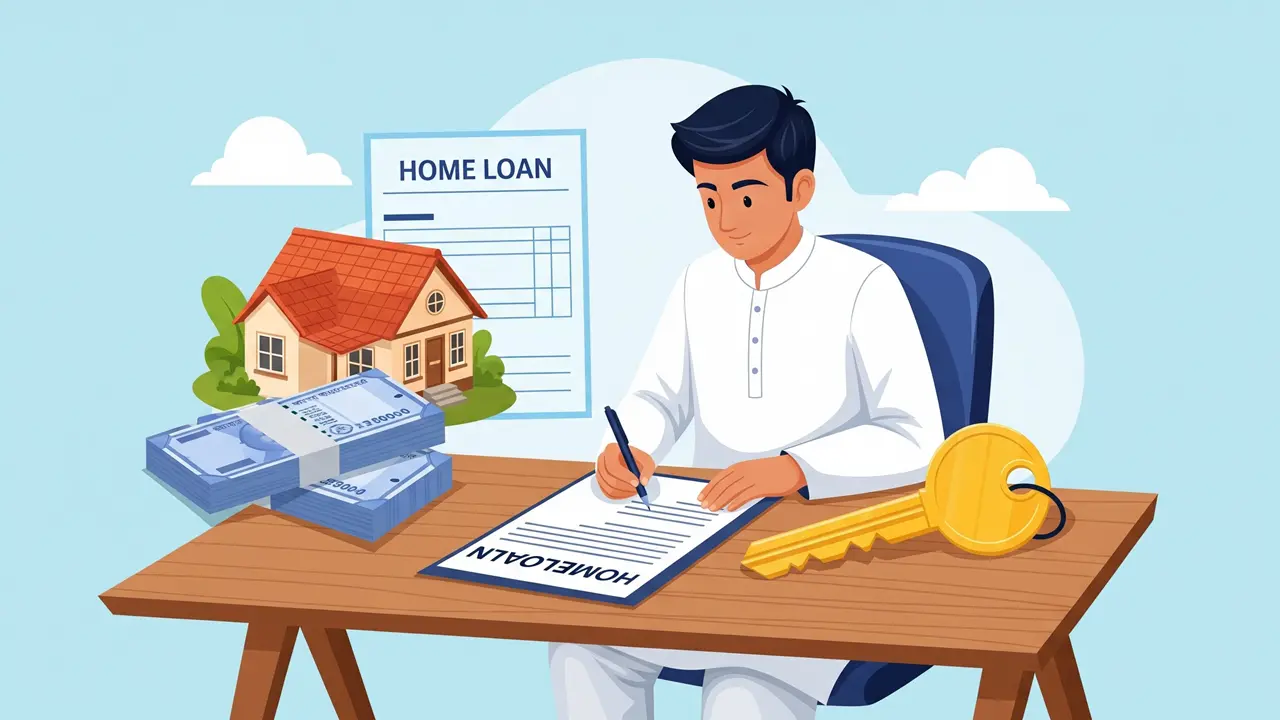Owning a home is a dream for many, but a low income can make it seem out of reach. With the right strategies, securing a home loan is possible even with limited earnings. Banks and financial institutions in India offer options tailored for various income levels. This guide provides timeless steps to help you get a home loan with low income and achieve homeownership.
Understanding Home Loans in India
A home loan is a borrowed amount from a bank or lender to purchase a property, repaid through monthly installments (EMIs). In India, home loans are offered by banks like SBI or private lenders like HDFC. Loan amounts depend on your income, credit score, and property value. Low-income earners can access loans with careful planning.
Business Loan
Get personal loan up to 5 CR
Home Loan
Get home loan up to 50 lakhs
Eligibility for a home loan hinges on your repayment capacity. Lenders assess your income, existing debts, and credit history. For low-income earners, smaller loan amounts and longer tenures make EMIs affordable. Understanding these basics helps you prepare effectively.
Why Low Income Makes Home Loans Challenging
Low income often limits loan eligibility due to repayment concerns. Banks prefer borrowers who can comfortably pay EMIs without straining their finances. For example, a ₹20,000 monthly income may restrict you to smaller loans. This makes it harder to afford properties in high-cost areas.
A low credit score can further complicate approval. Lenders also consider your debt-to-income ratio, which measures existing debts against income. Despite these challenges, strategic steps can improve your chances. Planning ahead is key to overcoming income barriers.
Step 1: Assess Your Financial Situation
Start by evaluating your income and expenses. Calculate your monthly take-home pay after taxes and deductions. For instance, if you earn ₹25,000 monthly, list expenses like rent, food, and transport to determine surplus funds. This shows how much you can allocate to EMIs.
Track your spending for a month to identify savings potential. Cutting non-essentials, like dining out, can free up money for loan repayments. Knowing your financial capacity helps set realistic loan expectations. It also guides discussions with lenders.
Step 2: Improve Your Credit Score

Aadhar Pe Loan
Get aadhar loan up to 1 lakhs
Personal Loan
Get personal loan up to 5 lakhs
A good credit score, ideally above 750, boosts loan approval chances. Your CIBIL score reflects your repayment history and credit usage. Paying bills and EMIs on time strengthens your score. A higher score may also secure lower interest rates.
Check your CIBIL report for errors, like incorrect late payments, and correct them promptly. Keep credit card balances low, ideally below 30% of the limit. For example, on a ₹1 lakh limit, maintain a balance under ₹30,000. A strong score signals reliability to lenders.
Step 3: Choose a Co-Applicant or Guarantor
Adding a co-applicant, like a spouse or family member with stable income, improves eligibility. Their income is considered, increasing the loan amount you qualify for. For instance, combining a ₹20,000 income with a co-applicant’s ₹30,000 boosts your repayment capacity. This makes lenders more confident.
A guarantor, who agrees to repay if you default, also strengthens your application. Ensure the co-applicant or guarantor has a good credit score. This strategy is effective for low-income borrowers. It enhances your loan approval odds.
Step 4: Opt for a Smaller Loan Amount
Low-income earners should target affordable loan amounts. For example, instead of aiming for a ₹50 lakh loan, consider a ₹15-20 lakh loan for a modest property. Smaller loans mean lower EMIs, fitting your budget better. This reduces the risk of default.
Focus on properties in affordable areas or smaller homes. For instance, a 2BHK in a developing suburb may cost less than a city-center flat. Aligning the loan with your income ensures manageable repayments. Smaller loans are easier to secure and repay.
Step 5: Choose a Longer Loan Tenure
Extending the loan tenure lowers monthly EMIs. For a ₹20 lakh loan at 8% interest, a 20-year tenure results in lower EMIs than a 10-year tenure. This makes payments affordable for low-income earners. However, longer tenures increase total interest paid.
Calculate EMIs using online calculators to find a balance. Ensure the EMI doesn’t exceed 40% of your monthly income. Longer tenures provide breathing room for tight budgets. They make homeownership more achievable.
Step 6: Explore Government Housing Schemes
Government schemes like the Pradhan Mantri Awas Yojana (PMAY) support low-income homebuyers. PMAY offers subsidies on home loan interest for eligible borrowers. For example, a subsidy of up to ₹2.67 lakh reduces your loan cost. This makes homeownership more affordable.
Check eligibility on the PMAY website or with your lender. These schemes target economically weaker sections and lower-income groups. Documentation, like income proof, is required to apply. Such programs significantly ease the loan burden.
Step 7: Compare Lenders for Better Terms
Different lenders offer varying interest rates and terms. Public banks like SBI often have lower rates than private lenders. For example, SBI’s home loan rates may start at 8%, while private banks charge 9-10%. Comparing options saves money over the loan’s tenure.
Use platforms like BankBazaar to compare loan offers. Check processing fees, prepayment penalties, and eligibility criteria. Choose a lender with flexible terms for low-income borrowers. Research ensures you get the best deal.
Common Mistakes to Avoid
Avoid applying for multiple loans simultaneously, as this triggers hard inquiries that lower your CIBIL score. Space out applications to protect your credit profile. Each rejection can further reduce your chances. Apply only when prepared with all documents.
Don’t borrow beyond your repayment capacity. Taking a ₹30 lakh loan on a ₹20,000 income strains your finances. Calculate affordable EMIs before applying. This prevents default and financial stress.
Ignoring documentation is another error. Incomplete or incorrect documents lead to rejections. Ensure you have income proof, ID, and property papers ready. Proper preparation streamlines the approval process.
Tools to Simplify the Process
Technology aids home loan planning. Online EMI calculators estimate monthly payments based on loan amount, tenure, and interest rate. For example, input ₹15 lakh at 8% for 20 years to see your EMI. These tools help you plan realistically.
Loan comparison platforms like Paisabazaar provide rate comparisons and eligibility details. Many banks offer pre-approval checks online. Using these tools saves time and ensures informed decisions. They’re accessible and user-friendly.
Tips for Long-Term Success
Build a savings habit to cover down payments and EMIs. Save ₹2,000 monthly to accumulate a ₹1 lakh down payment in 4 years. This reduces the loan amount needed. Consistent savings strengthen your application.
Maintain a good credit score by paying existing debts on time. Avoid high-interest loans, like credit card loans, which strain your budget. A disciplined approach ensures loan affordability. These habits support homeownership goals.
Conclusion
Getting a home loan with low income is achievable with careful planning. By improving your credit score, choosing smaller loans, and leveraging government schemes, you can secure financing. Comparing lenders and avoiding common mistakes further boosts your chances. Start today to take steps toward owning your dream home.
FAQs
1. Can I get a home loan with low income?
Yes, by choosing smaller loans, longer tenures, or adding a co-applicant. Government schemes like PMAY also help.
2. How does my CIBIL score affect a home loan?
A score above 750 improves approval chances and secures lower interest rates. Pay bills on time to boost your score.
3. What is a good loan amount for low income?
Aim for a loan where EMIs are below 40% of your income. For ₹20,000 monthly income, target ₹10-15 lakh loans.
4. How can government schemes help low-income borrowers?
Schemes like PMAY offer interest subsidies, reducing loan costs. Check eligibility with your lender or PMAY website.
5. What documents are needed for a home loan?
Provide income proof, ID, address proof, and property papers. Ensure all documents are accurate to avoid rejections.
